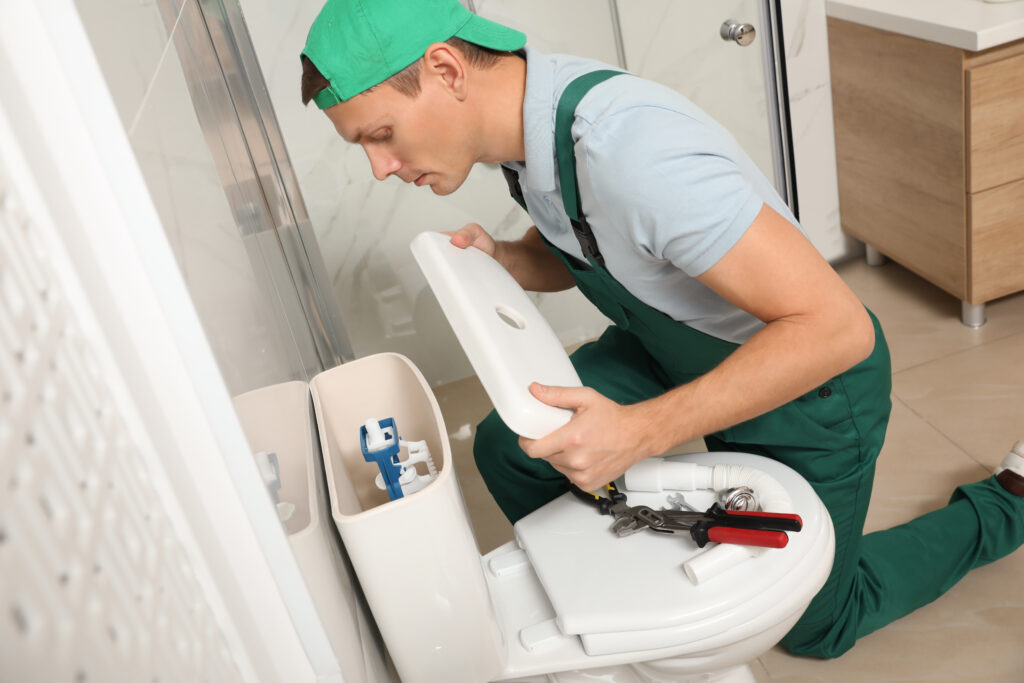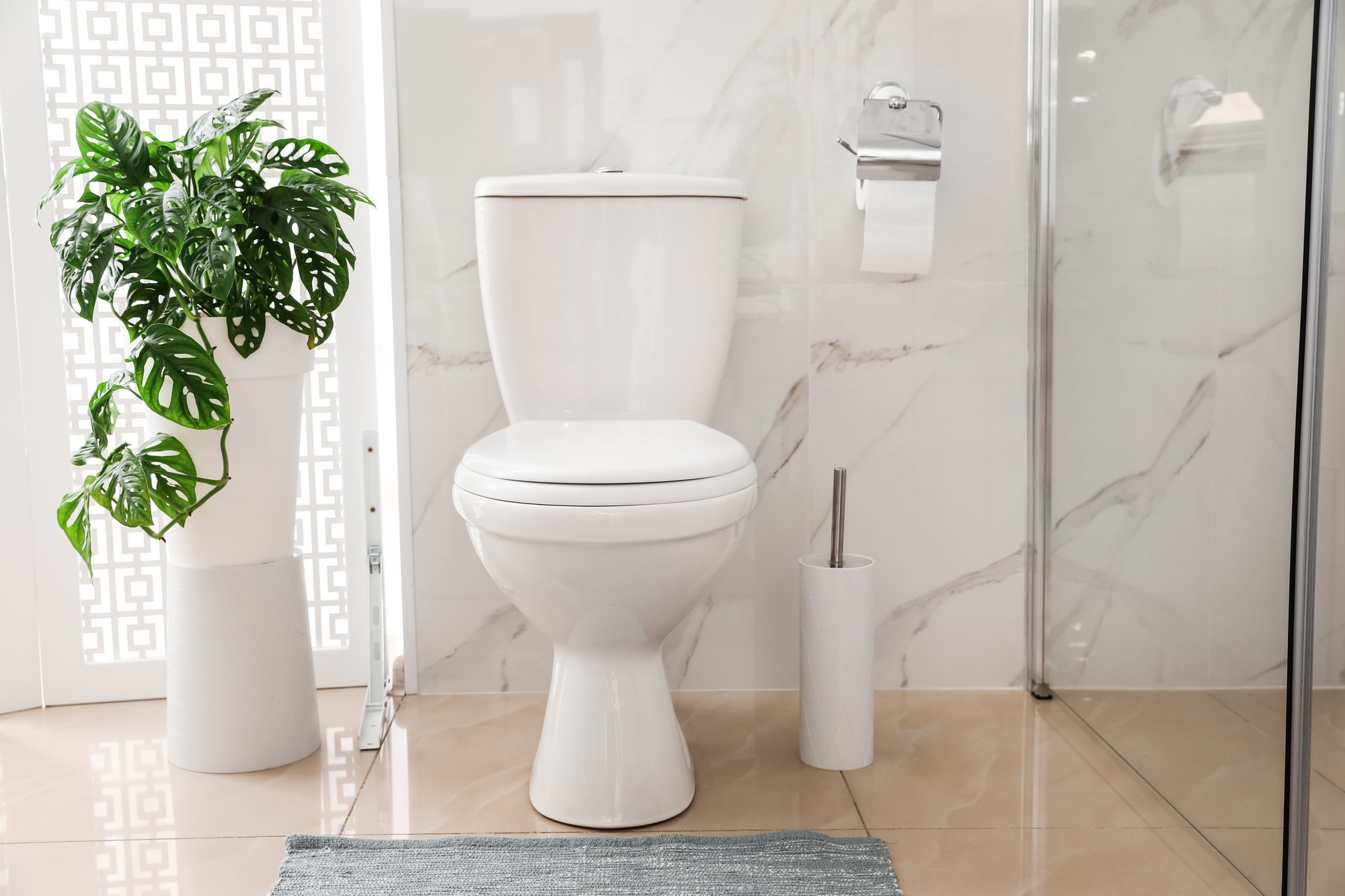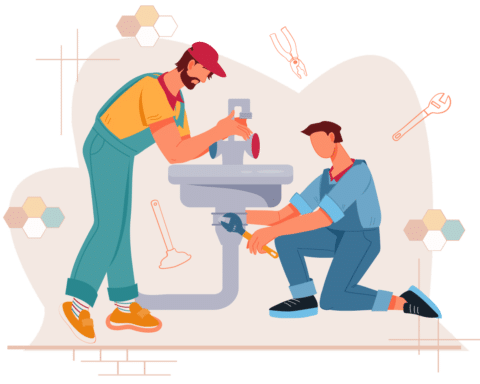What is “Toilet Hissing?”
A hissing noise from your toilet is often high-pitched and produced when water flows from the tank into the toilet bowl. It can be described as a faintly audible whistling or hissing noise that can be heard from a short distance away.
How a Toilet Works
Understanding the how is vital before you can understand the why. A toilet works by filling a tank with water from a home’s plumbing system and then releasing that water into the toilet bowl when it’s flushed via a series of valves inside.
The Role of the Toilet Tank and Toilet Bowl
The toilet tank and bowl are both essential components of a toilet, each with its role to play.
The toilet tank is designed to hold a reserve of water used to flush the toilet. When the toilet is flushed, a valve opens at the bottom of the tank, and water flows into the toilet bowl. The tank is then refilled with water from the home’s plumbing system via fill valves or a ball cock.
The toilet bowl is a part of the toilet that collects waste and water. Water flows from the tank, creating a siphon effect. This pulls debris from the bowl down into the drain pipe.
The bowl is also designed to hold a small amount of water at all times, which helps to prevent odors from escaping from the drainpipe.
Flush Valve Assembly
The flush valve assembly controls the water flow from the tank into the bowl. It consists of a flapper valve, which is a rubber or plastic seal that covers the opening at the base of the tank. It is connected to a chain or lift wire that is attached to a lever on the outside of the tank. When the lever is pushed down, it lifts the flapper valve, allowing water to drain.
The flush valve assembly also includes an overflow tube that prevents the toilet from overflowing and a flush valve seat that creates a watertight seal to prevent water from leaking when the toilet is not in use.
The Fill Valve
The fill valve controls the water level in the toilet tank. Its purpose is to ensure that there is enough water in the tank to complete a flush and to refill the tank after.
The fill valve opens when the toilet tank needs to be filled with water and closes when the water in the tank reaches the appropriate level, which is determined by a float attached to the valve.
The fill valve also has a built-in overflow tube that prevents the tank from overflowing and a shut-off valve that allows the water supply to the toilet to be turned off if necessary.
Overall, the fill valve plays a critical role in maintaining the proper water level in the toilet tank, which is essential for the toilet to function properly.
Rubber Flapper
The rubber flapper acts as a seal between the toilet tank and bowl. It is typically made of rubber or plastic and is attached to the flush valve assembly with a chain.
When the toilet is not in use, the flapper sits on the valve seat at the bottom of the tank, creating a watertight seal. When the toilet flushes, the chain or lift wire lifts the flapper, allowing water to flow from the tank. Once the water has drained, the flapper falls back onto the valve seat.
The rubber flapper is an important component of the toilet’s system, and if it becomes worn or damaged, it can cause leaks or other problems with the toilet’s operation.
Why Toilets Might Hiss

A hissing sound means one of several things could be happening:
- Leaking fill valve: If the fill valve is not shutting off completely, water can continue to flow into the toilet tank, causing it to overfill and create a hissing sound. This can be caused by a worn or damaged valve or by debris that has become trapped.
- Leaking flush valve: If the flapper valve is not sealing properly, water can slowly leak out of the tank and into the bowl, causing the tank to refill constantly and creating a hissing sound.
- Faulty ball cock assembly: A malfunctioning ball cock assembly, which controls the fill valve, can also be the source of a hissing toilet. This can be caused by a worn or damaged float, which can prevent the ball cock from shutting off the fill valve,
- Water pressure issues: If the water pressure in the home is too high, it can cause the fill valve to create a hissing sound as it struggles to regulate the flow of water into the toilet’s tank.
In general, a hissing toilet is a sign that something is not working properly. You may need to hire someone to repair or replace a portion of your toilet if you cannot.
Types of Toilet Hissing Problems
The Toilet Hisses Randomly Every Few Minutes
This is likely due to a faulty or blocked fill valve. As we already know, the fill valve controls the water flow. If it’s not shutting off completely, it can continue to periodically allow a narrow stream or water out, causing an overflow from the excess water, and, not to mention, it will raise your water bill.
Toilet Hissing Continuously
The most common reason you might have a constant hissing noise is either a faulty fill or flush valve, which will cause something not to seal properly.
To eliminate the problem, check each of the two valves and if one is faulty, replace it.
When Hissing Toilets Don’t Flush
This is often due to the flapper chain malfunctioning. The chain attached to the handle could be the wrong length, or it could be broken. If the chain isn’t the correct length, the flap valve, usually a flat piece of hard plastic, won’t seal. Try increasing the chain length to see if your toilet flushes.
The Double Trouble Toilet: Hissing and Leaking Solutions
If you have a leaky toilet that’s making far too much noise, check your water pressure. If it’s too high, the water supply will struggle to reach its destination.
You can also double-check each seal and ensure it’s in good shape. Even one faulty seal can lead to a leak inside or out.
How to Stop a Toilet from Hissing
A hissing toilet is a common phenomenon found in most households at one time or another. The good news is, toilet hissing noise is usually an easy fix accomplished with a handful of inexpensive parts.
Doing preventive maintenance can help with some of these issues. Any repair to consider doing yourself is to replace the two scores and washers that secure the tank to the bowl. This can help prevent a leak and the need to call a plumber.
Before any maintenance, shut off the toilet’s water supply valve. That valve is what automatically refills the refill tank from the water line. Make sure to turn off the valve. Please realize this will stop the hissing noise because the water supply pipe has been blocked, but it does not resolve the issue.
Looking into replacing the fill valve seal is a good first step.
Get Professional Help!
If the hissing continues, seek professional help. To find a highly reviewed worker in your area, you can reference Angi’s List or Yelp.
It is better to call someone than to damage something beyond your capabilities.





